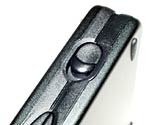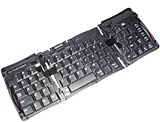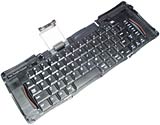
Palm Portable Keyboard
Review date: 11 May 2000.Last modified 03-Dec-2011.
Many portable computing gadgets live in the grey area between "productivity tool" and "party trick". Here's a perfect example.
You take this tough little metal-cased wallet thing, only barely bigger than a Palm organiser.
You press the catch on the side.
It pops open.
You pull the ends outwards.
Which results in it lying flat.
You push the red-striped end pieces inwards, and fold up the little stand.
And you plug your Palm into it.
Applause, wolf-whistles, and cries of "where can I buy one of those?" ensue.
Well, unless you're doing the trick in an apparently abandoned train station, because then you're probably just going to get mugged.
The gadget is the Palm Portable Keyboard, the only officially-branded keyboard-gadget for Palm organisers, and easily the best for show-off purposes.
Closed, it's 93mm by 130mm by 20mm (3.6 by 5.1 by 0.79 inches). Opened up, it's 352mm by 130mm by 9mm (13.8 by 5.1 by 0.3 inches). It weighs only 211 grams (7.9 ounces). Its US list price is $US99; it sells here in Australia for $AU245. It needs no batteries; it draws a little power from the Palm while you're typing, but shouldn't make much difference to battery life unless you're a really enthusiastic user.
The version I checked out is the one for the Palm III and VII-series organisers. And, of course, the original IBM Workpad, which is just a Palm III with a black case. There's another version available for V-series Palms.
The opposition
Probably the most popular Palm keyboards, though, are Landware's GoType range. They've been around for some time now; the Portable Keyboard's a much newer product.
I got a GoType for my Palm IIIx some time ago. The review's here.
GoTypes are neat little things, if not as neat as the Portable Keyboard. They're covered by a fold-up hard case that the Palm leans against when it's plugged in, using the same sync/expansion port connection as the Portable Keyboard.
On a GoType, you get 61 keys, plus the six green rubber buttons at the top that mimic the Palm's own four bottom application buttons, and give you extra "Mail" and "Find" keys too.
On the Portable Keyboard, there are 65 keys, plus four smaller side buttons which, again, duplicate the function of the Palm's own four bottom buttons.
As with the Portable Keyboard, the GoType comes in Palm III/VII and V versions. The plain GoType is for the III and VII, and costs $AU199.95; the GoType Pro is for the V, and costs $229.95. Both weigh more than the Portable Keyboard, but not a lot more. The GoType weighs 311 grams; the GoType Pro's a little heavier.
The GoType keyboard is one of those pedestrian ones that doesn't have fancy hinges and catches. Since it can't fold up, it has to use mini keys, in order that the thing not be too awkward to carry around. GoType keys are 17mm wide horizontally - almost as wide as the keys on a full size keyboard - but they're only 13.5mm vertically. Full size keys are 19mm square.
The difference is obvious.
The GoType keys are also a bit wobbly, since they use the time-honoured perched-on-a-stalk design that makes the keyboard cheap and simple, but leaves you with a less than optimal typing experience. Between the smallness and the wobbliness, the GoType's a bit annoying to use.
But the Portable Keyboard's not perfect, either.
Using it
As with other Palm keyboards, you make the Portable Keyboard work by installing a program, that lets the Palm understand what the keyboard's saying to it. You just double-click the keyboard.prc file on the (nearly empty) CD that comes with the keyboard, and the support program's installed when you next sync your Palm.
Incidentally, you can get an updated v1.1 version of the driver from the Palm site, here.
And as with the GoTypes, you can customise what the special buttons do, and there's a "Function" key that lets you quickly select standard on-screen buttons without reaching for the stylus.
The big deal, though, is the feel of the thing. Which is not perfect.
The Portable Keyboard's rubber feet make inadequate contact with the surface it's sitting on. Given its bendy design, it tends to skate around a bit while you're typing. The GoType stays in one place better. You might be able to anchor the Portable Keyboard more effectively by adding stick-on rubber feet to the case halves, but it wouldn't be a very elegant solution.
The Portable Keyboard also sits dead flat on the desk - it doesn't have a stand to angle the keyboard more naturally towards you. The GoType has a bit of tilt built in, and it's surprising how much nicer it feels because of it.
Palm want you to believe that the Portable Keyboard has "great-feeling, responsive keys". Well, no. It's got laptop keys, of course. Full size, but with very little travel. If you don't mind typing on a laptop sitting dead flat on a desk (as laptop keyboards generally do), then the Portable Keyboard isn't any worse. And its key-feel is certainly better than the GoType's.
But it's not nearly as nice to type on as an ordinary el-cheapo desktop keyboard, let alone the monster clicky buckling-spring 'boards that keyboard snobs like me prefer.
Mind you, I'm pretty sure you can get whole notebook computers, with hard drives and screens, that weigh less than a buckling spring keyboard.
The Portable Keyboard manual (duplicated, in Acrobat format, on the software CD - possibly just so the CD'd have more than 26 kilobytes of data on it) specifies that the keyboard is to be used on a "hard, flat surface".
If you have a hard, flat lap, Palm are apparently perfectly happy for you to use the keyboard there. Otherwise, you're on your own.
In practice, the Portable Keyboard isn't too awful to use in your lap. There's just no support to speak of for the poor Palm, which is held in place only by the connector and the dinky wire support hinge behind it. The GoType doesn't hold the Palm in place very well either, but at least it's got a little plinth around the connector. If there's side-to-side motion of the surface a GoType's on - if, for instance, you're using it on a bus - the Palm will stay put. But it takes very little tilt to the left or right to unplug a Palm from the Portable Keyboard's connector, and send it rattling to the floor.
Only the first and third of the three hinges in the Portable Keyboard lock in place. The middle hinge is always free to move, but it can only bend one way - upwards. This means that if you put the Portable Keyboard in your lap with each end of it balanced on a leg, the middle hinge will sag but not collapse, and your little key-encrusted suspension bridge will stay in place. But I doubt this is a wise move; the Portable Keyboard can't be that strong, and it really wants to have some support in the middle.
Which to choose?
If your Palm keyboarding will be limited to table-type surfaces, the Portable Keyboard is great. Sure, it skates around a bit. But given its diminutive proportions and less-than-totally-ridiculous price, it's a magnificent piece of gear.
If you want to enter text in more peculiar locations, though, a GoType doesn't feel that much worse to type on, is less likely to toss your Palm onto the floor if bumped, and costs less.
Frankly, I find it hard to choose between them, in practical terms.
If you want to pose, though, the Portable Keyboard beats the GoType any day.
Pros: |
Cons: |
|
|
Palm Portable Keyboard kindly provided by Eworld.










